Keywords
|
| UPQC, power quality, wind generating system (WGS). |
INTRODUCTION
|
| Wind energy is one of the most available and utilizable forms of renewable energy. Among the different renewable energy sources, wind energy has emerged as the most possible source of electrical power, and is economically spirited with the conventional sources. |
| Since then there has been an increasing attempt to build wind driven generators for use in secluded communities with minor resources in the type of water power or coal power, and at places which cannot be efficiently connected to public supply networks. Another motive for the worldwide concern in developing wind power plants is the rapidly increasing demand for electrical energy and the resultant depletion of fossil fuels, namely, coal and oil, whose reserves are limited. |
| The growth of wind energy for electrical power generation got improve when, in the early decades of the twentieth century, aviation equipment resulted in an enhanced accepting of the forces acting on blades moving through air. This resulted in the development of turbines with two or three blades. |
| The grouping of wind energy into existing power system presents a practical challenges and that requires indication of voltage stability, regulation, power quality problems. The power quality is an important customer focused measure and is greatly artificial by the operation of a transmission and distribution network. The problem of power quality is of great meaning to the wind turbine. There has been an extensive growth and quick enlargement in the utilization of wind energy in recent years. The separate units can be of large power up to 2 MW, feed into distribution network. |
POWER QUALITY & ITS ISSUES
|
| Power quality determines the strength of electrical power to consumer strategy. Synchronization of the voltage frequency and phase allows electrical systems to function in their proposed behavior without considerable loss of performance or life. The term is used to explain electric power that drives and electrical load & the loads ability to function suitably. Without the suitable power, an electrical device may failure, fail impulsively or not operate at all. There are several ways in which electric power can be of poor quality and several new causes of such poor quality power. |
| The different classifications for power quality issues, each using a specific property to categorize the problem. |
| 2.1 Power Quality Issues: |
| ? Harmonics |
| ? Interharmonics |
| ? Signaling voltage |
| ? Voltage fluctuation |
| ? Voltage dips |
| ? Voltage imbalance |
| ? Power frequency variations |
| Harmonics: |
| Harmonics are sinusoidal voltages or currents with frequency that are integer multiples of the power system frequency. For example the frequency of the hth harmonics is (hf). Constant non sinusoidal waveforms can be subjected to Fourier series and can be festering into the sum of harmonics and fundamental component. Main sources of harmonics in power systems are industrial non linear loads such as power electronic equipments for example rectifiers, drives, inverters, or loads, generating electrical arcs for example arc furnace, welding machines. |
UNIFIED POWER QUALITY CONDITIONER
|
| The Unified Power Quality Conditioner is a tradition power device that is engaged in the distribution system to diminish the disturbances that affect the performance of sensitive and/or critical load. It is a type of hybrid APF and is the only versatile device which can mitigate several power quality problems related with voltage and current simultaneously therefore is multi functioning devices that compensate various voltage disturbances of the power supply, to correct voltage fluctuations and to prevent harmonic load current from entering the power system. |
| UPQC has shunt & series compensation capabilities for harmonics, reactive power, voltage disturbances, and power flow control. Normally a UPQC consists of two voltage source converters with a common DC link designed in single phase, three phase three wire, or three phase four wire configurations. One converter is connected in series through a transformer between the source & the critical load at the PCC and operates as a voltage source inverter (VSI). The other converter is connected in shunt at the PCC through a transformer and operates as a current source inverter. |
| The main purpose of a UPQC is to compensate for supply voltage power quality issues, such as, sags, swells, unbalance, flicker, harmonics, and for load current power quality problems, such as, harmonics, unbalance, reactive current, and neutral current. The key components of this system are as follows. |
| 1) Two inverters - one connected across the load which acts as a shunt APF and other connected in series with the line as that of series APF. |
| 2) Shunt coupling inductor Lsh is used to interface the shunt inverter to the network. It also helps in smoothing the current wave shape. Sometimes an isolation transformer is utilized to electrically isolate the inverter from the network. |
| 3) A common dc link that can be formed by using a capacitor or an inductor. In Fig. 1, the dc link is realized using a capacitor which interconnects the two inverters and also maintains a constant self-supporting dc bus voltage across it. |
| 4) An LC filter that serves as a passive low-pass filter (LPF) and helps to eliminate high-frequency switching ripples on generated inverter output voltage. |
| 5) Series injection transformer that is used to connect the series inverter in the network. A suitable turn ratio is often considered to reduce the voltage and current rating of series inverter. |
CONTROL SCHEME
|
| The Unified Power Quality Conditioner having two types of controller one is shunt UPQC controller; it is responsible to determine the compensating current references for PWM control of the UPQC shunt converter. Another one is series UPQC controller; it is responsible to determine the compensating voltage references for PWM series converter. |
| SHUNT UPQC CONTROLLER |
| The shunt UPQC controller is connect with the shunt transformer in transmission line, it is used for determine the compensating current references for PWM control of the UPQC shunt converter. It is used the current minimization algorithm. |
| CURRENT MINIMIZATION ALGORITHM |
| It determines the instantaneous compensating current references, which should be synthesized by the shunt PWM converter of the UPQC. It has the same kernel as the Generalized Fryze Currents methods widely used. The inputs of the controller are the load currents 1 1 1 , , a b c i i i the control voltages 1 1 1 , , a b c v v v determined by the 1 v ? detector, and the DC voltage regulator signal l o s s G . |
| Since the shunt active filter of the UPQC compensates the difference between the calculated active current and the measured load current, it is possible to guarantee that the compensated currents , , a s b s c s I I I drawn from the network are always sinusoidal, balanced and in phase with the positive sequence system voltages |
| SERIES UPQC CONTROLLER |
| The series UPQC controller is connect with the series transformer in transmission line, it is used for determine the compensating voltage references for PWM control of the UPQC series converter. It is used the damping control algorithm. |
| DAMPING CONTROL ALGORITHM |
| In a UPQC configuration, instability problems due to resonance phenomena may occur. In order to enhance the overall system stability, an auxiliary circuit can be added to the controller of the series active filter. The basic idea consists in increasing harmonic damping, as a series resistance, but effective only in harmonic frequencies, others than the fundamental one. This damping principle was first proposed by Peng, in terms of components defined in the pq theory and used by Aredes and Fujita. The damping control algorithm now developed in terms of abc variables. The inputs to the damping circuit are the source currents , , a s b s c s I I I which are flowing through the series transformers of the UPQC, and the voltages determined by the 1 v? voltage detector 1 1 1 , , a b c v v v . The active and non-active instantaneous powers are determined by using the given equations. |
 (1) (1) |
 (2) (2) |
| Were, |
 (3) (3) |
 (4) (4) |
 (5) (5) |
| Note that the voltages , , aq bq cq v v v are achieved from the fundamental positive sequence voltages 1 1 1 , , a b c v v v . Therefore, it is possible to guarantee that the voltages , , aq bq cq v v v are still sinusoidal and lag 90º the voltages 1 1 1 , , a b c v v v respectively. A conductance G and a susceptance B are determined from the calculated active and non active instantaneous powers. Then, high pass, fifth order Butterworth filters are used to extract the oscillating parts of that conductance and susceptance. |
| The auxiliary currents , , ap bp cp i i i and , , aq bq cq i i i are determined as follows: |
 |
 |
 |
 |
 |
 |
| Damping signals (harmonic components still present in the source currents) are determined as follows: |
 |
 |
 |
| Finally, the multiplication between the damping signals , , ah bh ch i i i and a gain K determines the damping voltages , , ah bh ch v v v . That will be added to the compensating voltage references of the series active filter of the UPQC, as will be explained in the next section. Thus, the gain K acts as a harmonic resistance to damp resonance phenomena. |
RESULTS
|
| Project simulation diagram shown in the figure. The wind energy system is connected in grid with the three phase source. The Unified Power Quality Conditioner is connected in common of the wind energy and the three phase source grid. The wind energy is connected in grid, at the time source voltage & current is affect, because wind power systems used power electronic devices, such as rectifiers, inverters at the time introduces harmonics, that harmonics affect the source voltage & current. |
| The Unified Power Quality Conditioner is connected the grid, at the time series active filter is compensating the voltage, shunt active filter is compensating the current. Series active filter is used the damping control algorithm, this control algorithm is calculating the compensating voltages ( ac v , bc v , cc v ). Shunt active filter is used the current minimization control algorithm, this control algorithm is calculating the compensating currents ( ac i , bc i , cc i ). |
| When the wind energy is connected to the grid and with nonlinear load, harmonics are generated which affects the source current and so the waveform gets distorted as shown in Fig .3. |
| Fig. 3. shows the distorted current waveform before installing UPQC whereas Fig. 8. shows the pure sinusoidal current waveform (harmonics free waveform) which is obtained after installing UPQC. |
| The Fourier analysis is used find the THD value of source current. When UPQC is not connected to grid connected wind energy system, THD value is 30.42%, as shown in Fig. 9. |
| When UPQC is connected to grid connected wind energy system, THD value is 0.28%, as shown in Fig 5.6. The analysis shows that THD value is decreased to 0.28% from 30.42% after installation of UPQC. Thus UPQC performs better in enhancing the power quality. |
CONCLUSION
|
| This paper has proposed the method for compensating source voltage and current thereby enhancing power quality in the grid connected wind energy system by using Unified Power Quality Conditioner. The series UPQC controller compensates the source voltage by implementing damping control algorithm and shunt UPQC controller compensates the source current by using current minimization algorithm. Source voltage & current waveform of grid connected wind energy system is discussed with & without UPQC. These results are analyzed in MATLAB/SIMULINK software, and it is observed that integration of wind generation and UPQC have shown the outstanding performance in improving the power quality. |
Figures at a glance
|
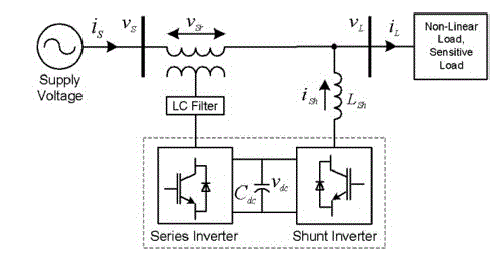 |
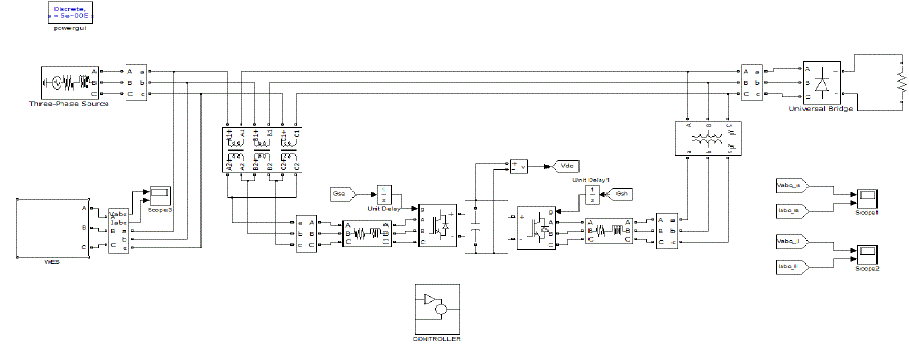 |
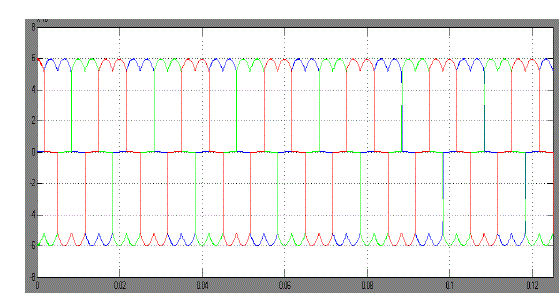 |
| Figure 1 |
Figure 2 |
Figure 3 |
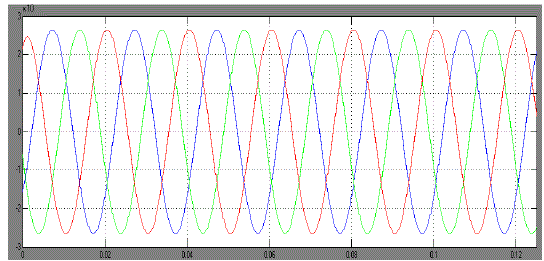 |
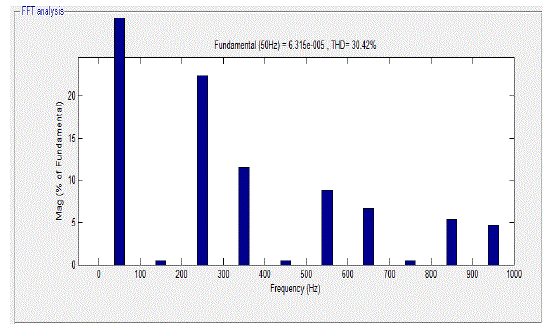 |
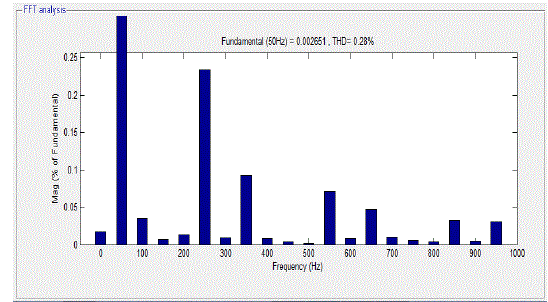 |
| Figure 4 |
Figure 5 |
Figure 6 |
|
References
|
- Sharad W. Mohod and Mohan V. Aware, “A STATCOM Control Scheme for Grid Connected Wind Energy System for Power QualityImprovement,” IEEE Systems Journal, Vol. 4, No. 3, September 2010.
- Luis F.C. Monteiro, MaurícioAredes, and Joao A. Moor Neto “A control strategy for unified power quality conditioner” COPPE/UFRJ,Electrical Engineering Program P.O.Box 68504, Rio de Janeiro, Brazil.
- Ahmet Teke, LutfuSaribulut, and Mehmet tumay “A Novel Reference Signal Generation Method for Power Quality Improvement ofUnified Power Quality Conditioner” IEEE Transactions on power delivery, vol. 26, no. 4, October 2011.
- Vinita Vasundhara, Rintu Khanna, Manoj Kumar “Improvement of Power Quality by UPQC Using Different Intelligent Controls: A Literature Review” International Journal of Recent Technology and Engineering (IJRTE) ISSN: 2277-3878, Volume-2, Issue-1, March 2013.
- Tatsuto Kinjo, Student Member, IEEE, TomonobuSenjyu, Member, IEEE, “Output Leveling of Renewable Energy by Electric Double LayerCapacitor applied for Energy Storage System” IEEE Transactions on Energy Conversion, Vol. 21, No. 1, March 2006.
- Shahab Mehraeen, Student Member, IEEE, S.Jagannathan,SeniorMember,IEEE,andMariesal. Crow, Fellow,IEEE “Novel DynamicRepresentation and Control of Power Systems with Facts Devices” IEEE Transactions On Power Systems, Vol. 25, No. 3, August 2010.
- Juan Manuel Carrasco, Member, IEEE, Leopoldo Garcia Tranquillo, Fellow, IEEE, Jan T. Bialasiewicz, Senior Member, “Power-Electronic Systems for the Grid integration of Renewable Energy Sources: A Survey” IEEE Transactions On Industrial Electronics, Vol. 53, No. 4, 2006.
|